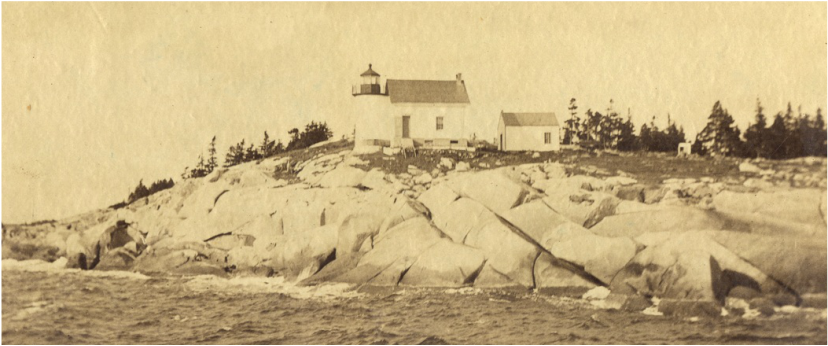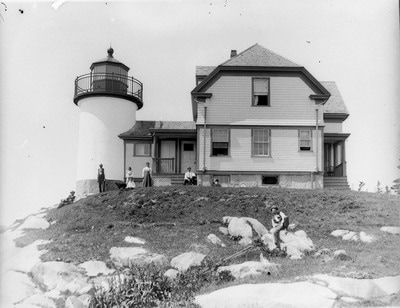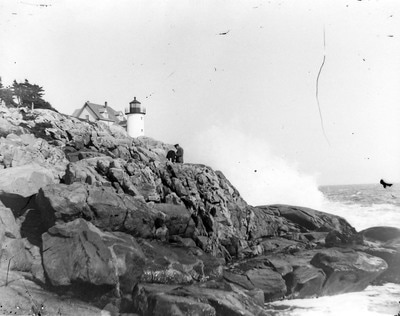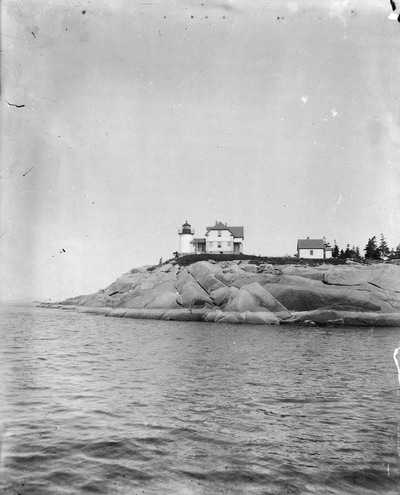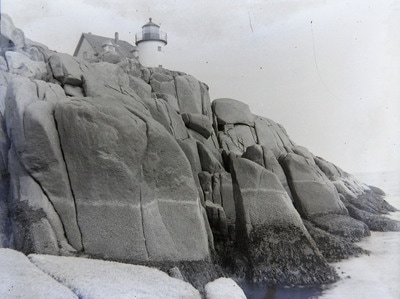History of Heron Neck Light, near Vinalhaven, Maine
© Jeremy D'Entremont. Do not reproduce any images or text from this website without permission of the author.
More information: Front page / Photos / Bibliography / Cruises / Postcards
Rocky, 400-acre Greens Island is a short distance off the southwest coast of the much larger island of Vinalhaven in Penobscot Bay, at the east entrance to Hurricane Sound. The island gets its name from an early resident, Joseph Green, who was 14 years old in 1757, when Indians killed his stepfather at Matinicus. Green escaped on a passing schooner, and he eventually took up residence at the southwest corner of the island that now bears his name. Green and his wife raised 14 children on the island.
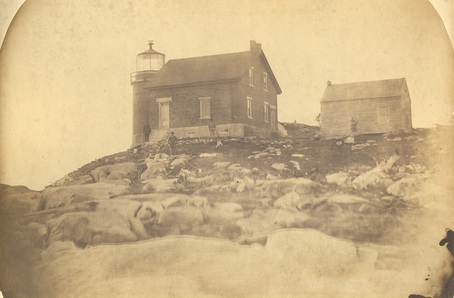
Circa 1859 (National Archives)
In August 1852, Congress appropriated $5,000 for a lighthouse on Greens Island, to help guide mariners heading for Vinalhaven’s Carver’s Harbor. The harbor area was settled by the Carver family in 1766 and was a center for fishing and lobster boats.
The light was established in February 1854. The 30-foot brick tower was attached to the keeper's house, also constructed of brick. A fifth-order Fresnel lens displayed a fixed red light 92 feet above the sea.
Heron Neck was always a single-family station. The first keeper, James G. Smith, a native of Vinalhaven, moved to the light station with his wife, Ann (Douglas), and their children. John Green succeeded Smith in 1870. An 1875 inspection report revealed that the keeper’s house was leaky and the “wall paper was all wet.” When Green died in 1883, his wife, Sara, served as keeper for a month before Nathaniel Hartwell arrived.
The light was established in February 1854. The 30-foot brick tower was attached to the keeper's house, also constructed of brick. A fifth-order Fresnel lens displayed a fixed red light 92 feet above the sea.
Heron Neck was always a single-family station. The first keeper, James G. Smith, a native of Vinalhaven, moved to the light station with his wife, Ann (Douglas), and their children. John Green succeeded Smith in 1870. An 1875 inspection report revealed that the keeper’s house was leaky and the “wall paper was all wet.” When Green died in 1883, his wife, Sara, served as keeper for a month before Nathaniel Hartwell arrived.
An 1886 book, Mary Bradford Crowninshield’s All Among the Lighthouses, described a visit to the station. Two hawks had been nesting on the island for 20 years. “The keepers had allowed no one to molest the birds, “ Crowninshield wrote, “but had fed them and made pets of them; so that the grateful creatures felt safe and at home in the place where they had received nothing but kindness.”
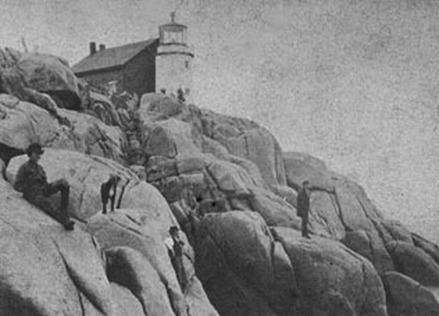
The Lighthouse Board’s annual report of 1890 revealed that the “old narrow and leaky stone deck and dilapidated lantern” of the lighthouse had been replaced. The following year’s report described the poor condition of the house:
The dampness of the dwelling is further increased by the character of the site, which is underlaid by a sloping ledge over which the water flows, saturating the soil surrounding the dwelling and keeping its cellar wet. From these causes the dwelling is unhealthy and it is unsuitable for occupancy in so severe a climate. It is claimed that on this account five deaths have occurred in it since its erection in 1853.
The dwelling was rebuilt in 1895; the 1854 tower remained and was attached to the new one-and-one-half-story, wood-frame house by a covered passageway. An oil house, which still stands, was added in 1903.
The dampness of the dwelling is further increased by the character of the site, which is underlaid by a sloping ledge over which the water flows, saturating the soil surrounding the dwelling and keeping its cellar wet. From these causes the dwelling is unhealthy and it is unsuitable for occupancy in so severe a climate. It is claimed that on this account five deaths have occurred in it since its erection in 1853.
The dwelling was rebuilt in 1895; the 1854 tower remained and was attached to the new one-and-one-half-story, wood-frame house by a covered passageway. An oil house, which still stands, was added in 1903.
The four circa 1900 photos in the gallery below are courtesy of Lyle Griffin. (Click on photos to enlarge.)
In October 1925, a 1,200-pound fog bell with striking machinery was added to the station, sounding a single blow every 15 seconds. Some years earlier, Heron Neck had a famous “fog dog.” In the early 1900s, Nemo—described as a “big, handsome Newfoundland”—was taught by Keeper Levi Farnham to bark loudly when he heard foghorns from approaching boats.
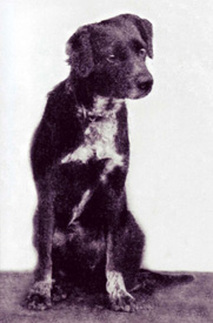
Nemo (American Lighthouse Foundation)
A contemporary article described Nemo in the pursuit of his duties:
As soon as the fog began to come in he seemed to realize that he was to be on duty, and went like a well-drilled soldier to his position at the extreme end of the Neck. There he waited patiently, until somewhere out of the murk came the sound of a whistle or a horn, to which he immediately responded by barking loudly. Sound carries well in a fog, and the intelligent creature’s voice was easily heard a long distance, and was a sufficient warning over a large area of danger.
One captain declared that he could hear Nemo farther than the fog-horn on the other side of the sound.
The dog never tired of his task, but remained at his station through all weather until the fog lifted, and the passing sailors could see their way again. Probably more than one vessel was saved from wreck and disaster by the timely warning of this four-footed sentinel of the sea.
The dog especially enjoyed barking his warning-greeting to the steamer Governor Bodwell, which made daily trips between Vinalhaven and Rockland. The keeper merely had to tell Nemo, “The Bodwell is coming,” and the dog went immediately to his post in expectation. When Nemo retired, Farnham trained a new “fog dog” named Rover.
As soon as the fog began to come in he seemed to realize that he was to be on duty, and went like a well-drilled soldier to his position at the extreme end of the Neck. There he waited patiently, until somewhere out of the murk came the sound of a whistle or a horn, to which he immediately responded by barking loudly. Sound carries well in a fog, and the intelligent creature’s voice was easily heard a long distance, and was a sufficient warning over a large area of danger.
One captain declared that he could hear Nemo farther than the fog-horn on the other side of the sound.
The dog never tired of his task, but remained at his station through all weather until the fog lifted, and the passing sailors could see their way again. Probably more than one vessel was saved from wreck and disaster by the timely warning of this four-footed sentinel of the sea.
The dog especially enjoyed barking his warning-greeting to the steamer Governor Bodwell, which made daily trips between Vinalhaven and Rockland. The keeper merely had to tell Nemo, “The Bodwell is coming,” and the dog went immediately to his post in expectation. When Nemo retired, Farnham trained a new “fog dog” named Rover.
Clinton L. “Buster” Dalzell, an assistant keeper, was married at the lighthouse to Elizabeth Smith in 1930. The bride and groom were both natives of Vinalhaven.
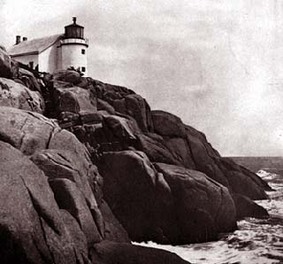
The light was electrified in 1948, and the fog signal was changed to an electric siren with one three-second blast every 30 seconds. Later that same year, the two-masted fishing schooner Fannie Belle crashed on ledges at Heron Neck, but no lives were lost. The vessel was abandoned but later salvaged.
The last civilian keeper was Andrew Bennett of Vinalhaven, who was replaced by Coast Guard keepers in 1948 after being at the station for over 20 years.
Paul Manning of the Coast Guard was an assistant keeper at the lighthouse in the late 1940s. Bill Parmenter was the officer in charge at the time. Manning later recalled that local fishermen kept the Coast Guardsmen supplied with lobsters and fish, especially in winter when the trip to Vinalhaven for supplies was difficult.
The last civilian keeper was Andrew Bennett of Vinalhaven, who was replaced by Coast Guard keepers in 1948 after being at the station for over 20 years.
Paul Manning of the Coast Guard was an assistant keeper at the lighthouse in the late 1940s. Bill Parmenter was the officer in charge at the time. Manning later recalled that local fishermen kept the Coast Guardsmen supplied with lobsters and fish, especially in winter when the trip to Vinalhaven for supplies was difficult.
The keepers' water for drinking and bathing came from two large cisterns in the basement. A well was dug in the late 1940s, but the water from the well turned out to be salty. The salt water was later used for the flush toilets in the new bathroom that replaced the earlier outhouses.
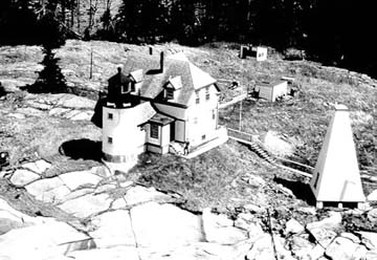
U.S. Coast Guard
Coast Guardsman Jim Woods was stationed at Heron Neck Light in 1960-61, and he later shared the following memories:
It consisted of a main house with the light attached, a generator building that held two generators, a paint locker and general storage. There was a boathouse at the water's edge on the cove, down the hill, in back of the station. We had a 14-foot skiff and outboard which we hauled up to the boathouse when not in use, due to the rise and fall of the tide. There was an electric winch to haul the skiff up on the rails to cover.
At high water we would unhook the boat and jump in for the fast ride to the water. The light had a crew of three. Officer in Charge (OinC) was a first class BM, Engineer was a second class engineman and a seaman or fireman. The house was about like a normal house -- three bedrooms, bathroom and living room, kitchen, office, and a cellar which was used for storage. The lighthouse was attached to the main house with a staircase to the light room with fog signal attached outside. We had electrical power from generators, and as I remember we got shore power at some point via underwater cable and also phone service.
Liberty was three weeks on and one week off. There were two on at all times except when someone had to make a run to town (Vinalhaven) for food supplies and mail. To get to town you had to go around a point on the island called 'Boiler Point.' You usually tried to go around it at high water as it was a rough water area. We tied the skiff up at the Calderwood fuel dock and walked to town or caught a ride with an islander. Since I was youngest of the crew I got to know the younger island crowd and have never met any more friendly people than the island folks. If we needed some kind of help they would help.
The light was automated in 1982, and the Coast Guard keepers were removed. A new 300mm lens replaced the old Fresnel lens. In April 1989, an electrical fire broke out in the empty keeper's house. The house was badly damaged. The Coast Guard claimed that an engineering survey showed that it would be impossible to restore the house to its original condition, so they announced plans to raze the building instead.
Preservationists objected, and in November 1993 the Coast Guard agreed to hand over the lighthouse station to the Island Institute of Rockland. The institute in turn leased the property to a private party who successfully restored the house. It was the Heron Neck project that inspired Island Institute vice president Peter Ralston to initiate the Maine Lights Program, under which 28 Maine lighthouses were turned over to communities and organizations.
The lighthouse property was eventually sold to the couple responsible for its resoration. Please keep in mind that the lighthouse and grounds are on private property and are not open to the public; be sure to respect the owners' privacy. Unfortunately, no regular cruises pass the light station, so you'll have to charter a cruise or flight for a good view.
Keepers: (This list is a work in progress. If you have any information on the keepers of this lighthouse, I'd love to hear from you. You can email me at [email protected]. Anyone copying this list onto another web site does so at their own risk, as the list is always subject to updates and corrections.)
James Smith (1853-1861); John Ball (1861-1864); James Mills (1864-1869); John Green (1870-1883); Sarah J. Green (1883); Nathaniel Hartwell (1883-1890); Edward K. Tapley (1890-1900); Levi L. Farnham (1900-1911); Joseph A. Farnham (1911); Fred M. Robbins (1911-1930); Clinton Dalzell (assistant, c. 1928-?); Andrew Bennett (1930-1948); William Parmenter (Coast Guard, c. 1949-?); Paul Manning (Coast Guard, assistant, c. 1949); Ernest DeRaps (Coast Guard, 1959-1961); Kermit Scarborough (Coast Guard officer in charge, 1959-1961); James Woods (Coast Guard assistant 1960-61); Stanley Beal (Coast Guard officer in charge 1961-1962); Roy V. Louder (Coast Guard c.1962); Richard L. McCurley (Coast Guard c.1962); Murray R. Berger (Coast Guard officer in charge 1962-1964); Earl C. Adams (Coast Guard 1962-1963); Walter A. Dodge (Coast Guard 1962-1963); Rollo B. Gerrish (Coast Guard 1963-1964); Jack Bentley (Coast Guard 1963-1964); Douglas M. Pottle (Coast Guard 1963-1965); Earl C. Adams (Coast Guard 1964-1965); Charles Baldson (Coast Guard officer in charge 1964-1966); Bruce M. McGirr (Coast Guard, 1965); Floyd N. Linscott (Coast Guard 1965-1966); Jack M. Temple (Coast Guard 1965-1966); Bertrand G. Belisle (Coast Guard 1965-1966); Leon L. Tellinghuisen (Coast Guard, 1966); Herman G. Johnson Jr. (Coast Guard officer in charge 1966-1967); Allan J. Hamel (Coast Guard 1966-1967); David P. Speed (Coast Guard officer in charge 1967); ? Furr (Coast Guard 1967-1968); Timothy F. Davison (Coast Guard 1967-1968); Norman L. Wright (Coast Guard 1967-c.1969); Harold F. Beal Jr. (Coast Guard officer in charge 1967-c.1969); ? Perry (Coast Guard 1968-c1969); ? Leach (Coast Guard c.1969); Larry Uhl (Coast Guard BM3, 1971); Jack Peterson (Coast Guard c.1975)
It consisted of a main house with the light attached, a generator building that held two generators, a paint locker and general storage. There was a boathouse at the water's edge on the cove, down the hill, in back of the station. We had a 14-foot skiff and outboard which we hauled up to the boathouse when not in use, due to the rise and fall of the tide. There was an electric winch to haul the skiff up on the rails to cover.
At high water we would unhook the boat and jump in for the fast ride to the water. The light had a crew of three. Officer in Charge (OinC) was a first class BM, Engineer was a second class engineman and a seaman or fireman. The house was about like a normal house -- three bedrooms, bathroom and living room, kitchen, office, and a cellar which was used for storage. The lighthouse was attached to the main house with a staircase to the light room with fog signal attached outside. We had electrical power from generators, and as I remember we got shore power at some point via underwater cable and also phone service.
Liberty was three weeks on and one week off. There were two on at all times except when someone had to make a run to town (Vinalhaven) for food supplies and mail. To get to town you had to go around a point on the island called 'Boiler Point.' You usually tried to go around it at high water as it was a rough water area. We tied the skiff up at the Calderwood fuel dock and walked to town or caught a ride with an islander. Since I was youngest of the crew I got to know the younger island crowd and have never met any more friendly people than the island folks. If we needed some kind of help they would help.
The light was automated in 1982, and the Coast Guard keepers were removed. A new 300mm lens replaced the old Fresnel lens. In April 1989, an electrical fire broke out in the empty keeper's house. The house was badly damaged. The Coast Guard claimed that an engineering survey showed that it would be impossible to restore the house to its original condition, so they announced plans to raze the building instead.
Preservationists objected, and in November 1993 the Coast Guard agreed to hand over the lighthouse station to the Island Institute of Rockland. The institute in turn leased the property to a private party who successfully restored the house. It was the Heron Neck project that inspired Island Institute vice president Peter Ralston to initiate the Maine Lights Program, under which 28 Maine lighthouses were turned over to communities and organizations.
The lighthouse property was eventually sold to the couple responsible for its resoration. Please keep in mind that the lighthouse and grounds are on private property and are not open to the public; be sure to respect the owners' privacy. Unfortunately, no regular cruises pass the light station, so you'll have to charter a cruise or flight for a good view.
Keepers: (This list is a work in progress. If you have any information on the keepers of this lighthouse, I'd love to hear from you. You can email me at [email protected]. Anyone copying this list onto another web site does so at their own risk, as the list is always subject to updates and corrections.)
James Smith (1853-1861); John Ball (1861-1864); James Mills (1864-1869); John Green (1870-1883); Sarah J. Green (1883); Nathaniel Hartwell (1883-1890); Edward K. Tapley (1890-1900); Levi L. Farnham (1900-1911); Joseph A. Farnham (1911); Fred M. Robbins (1911-1930); Clinton Dalzell (assistant, c. 1928-?); Andrew Bennett (1930-1948); William Parmenter (Coast Guard, c. 1949-?); Paul Manning (Coast Guard, assistant, c. 1949); Ernest DeRaps (Coast Guard, 1959-1961); Kermit Scarborough (Coast Guard officer in charge, 1959-1961); James Woods (Coast Guard assistant 1960-61); Stanley Beal (Coast Guard officer in charge 1961-1962); Roy V. Louder (Coast Guard c.1962); Richard L. McCurley (Coast Guard c.1962); Murray R. Berger (Coast Guard officer in charge 1962-1964); Earl C. Adams (Coast Guard 1962-1963); Walter A. Dodge (Coast Guard 1962-1963); Rollo B. Gerrish (Coast Guard 1963-1964); Jack Bentley (Coast Guard 1963-1964); Douglas M. Pottle (Coast Guard 1963-1965); Earl C. Adams (Coast Guard 1964-1965); Charles Baldson (Coast Guard officer in charge 1964-1966); Bruce M. McGirr (Coast Guard, 1965); Floyd N. Linscott (Coast Guard 1965-1966); Jack M. Temple (Coast Guard 1965-1966); Bertrand G. Belisle (Coast Guard 1965-1966); Leon L. Tellinghuisen (Coast Guard, 1966); Herman G. Johnson Jr. (Coast Guard officer in charge 1966-1967); Allan J. Hamel (Coast Guard 1966-1967); David P. Speed (Coast Guard officer in charge 1967); ? Furr (Coast Guard 1967-1968); Timothy F. Davison (Coast Guard 1967-1968); Norman L. Wright (Coast Guard 1967-c.1969); Harold F. Beal Jr. (Coast Guard officer in charge 1967-c.1969); ? Perry (Coast Guard 1968-c1969); ? Leach (Coast Guard c.1969); Larry Uhl (Coast Guard BM3, 1971); Jack Peterson (Coast Guard c.1975)
